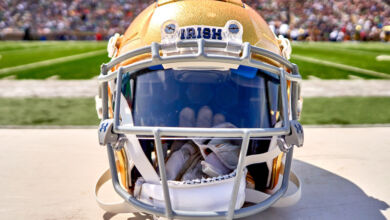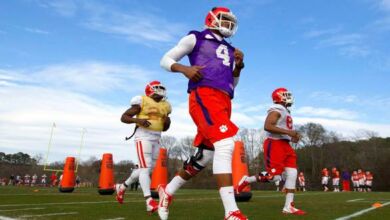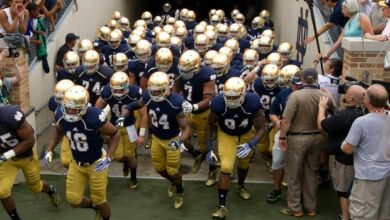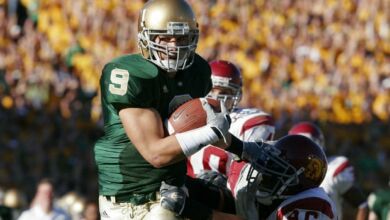Michigan week is upon us, a nauseous back-and-forth pissing contest about who has the better fight song, who has the better helmet, who has the better tradition. Michigan fans will never fail to remind Notre Dame fans how they taught us the game of football, meanwhile the Irish remind everyone who wants to know (and a lot of people who don’t) about how the “legends” of the Michigan coaching fraternity vaccilated between being ND-dodging pussies (Yost and Crisler) and ND-hating crybabies (Bo and Carr). In the eyes of Michigan fans, they are assured of one of two outcomes: either Michigan will beat Notre Dame or Michigan will beat itself. From Yost to Carr, in the 119-year history of the series, that’s how it’s always been. Either the Skunkbears defeat the Irish and everything is right with the world, or they lose because an obviously superior Michigan team underachieved (again) after which they then start beating the drum (again) about kicking us off their schedule (again).
Michigan has always had a huge chip on its shoulder, and nowhere is that more evident than their national championship claims.
A running gag in Notre Dame circles is how many national titles Alabama “owns”. As vetted in an earlier blog entry, Bama declares itself a 12-time national champion, including in its count A) the 1941 season in which they finished 20th in the AP poll with a 9-2 record while 8-0 defending national champion Minnesota (16-0 counting the ’40 season) was ranked #1 by the AP and nine other polling systems; B) the 1973 season in which Notre Dame not only beat Bama in the ‘73 Sugar Bowl 24-23, but was crowned national champions by the AP and five other polls; and C) a 1964 season in which the Tide won the national title and lost in the Orange Bowl. In the real world the 12-time national champion Crimson Tide is a 9 or 10-time champ at best.
Turns out Alabama can’t hold a candle to Michigan.
But first, a quick summary of some polling systems, courtesy of hickorysports.com.
Two organizations, the College Football Researchers Association (CFRA) and the National Championship Foundation (NCF), conducted polls of their members to determine national champions beginning with the 1869 season, when the first college football game was played. The Helms Athletic Foundation (HAF) conducted a similar poll of members beginning in 1883, the first year that American football used a point scoring system.
In 1926, Frank Dickinson, an economics professor at the University of Illinois, developed a system based on quality of opponents and scoring differentials, similar to many of today’s “power rating” methods (except that he had to do it by hand instead of using a computer).
Dickinson chose national champions for 1924 and 1925, as well as 1926, and he continued selecting champions through 1940. Similar systems were devised by Dick Dunkel Sr. in 1929, by Paul Williams in 1932, and by Edward E. and Frank Litkenhous in 1934.
In 1936, the Associated Press began its annual poll of sportswriters and sportscasters. United Press initiated a poll of college coaches in 1950 and the International News Service began polling its own sportswriters in 1952. When they merged into United Press International, the coaches’ poll became the UPI poll.
Other organizations got onto the poll bandwagon in the 1950s, most notably the Football Writers Association of America in 1954 and the National Football Foundation and Hall of Fame in 1959.
One problem these polls faced for many years was that they came out with their final results a few days after the regular season ended, and bowl games sometimes made those results look questionable.
The FWAA in 1955 began conducting its final poll after the bowls. AP did the same in 1965, then went back to a pre-bowl poll for the next two seasons. Since 1968, however, the final AP poll has been taken after the bowl results. The NFFHF began doing so in 1971, UP in 1974.
In the meantime, the UP/UPI poll of coaches became the American Football Coaches Association (AFCA) poll, which moved to USA Today/CNN in 1991 and to USA Today/ESPN in 1997. And then of course, there is the mind-numbingly complex BCS ranking system we have today.
The University of Michigan’s official athletic website lists 11 different years as national championship seasons for its football team: 1901, 1902, 1903, 1904, 1918, 1923, 1932, 1933, 1947, 1948, and 1997.
Let’s have a look, shall we?
1901: Michigan declared NC and HF champ, Harvard declared CF champ, . Verdict: co-champ
1902: Michigan near-consensus champion in all major polls. Verdict: champ
1903: Princeton near-consensus champion in all major polls. Verdict: no title
1904: Penn CF and HF champ, Michigan NC champ. Verdict: co-champ
1918: Pittsburgh CF and HF champ, Michigan NC champ. Verdict: co-champ
1923: Illinois CF and HF champ, Michigan NC champ. Verdict: co-champ
1932: USC champ in CF, NC, HF, Du, and Wi polls; Michigan NC Champ. Verdict: co-champ
1933: Michigan CF, NC, HF, Di champ; Ohio St Du champ; USC champ in Wi poll. Verdict: co-champ
(Note: Beginning in 1936 the AP champ became widely regarded as the consensus national champion, with the UPI playing second fiddle until the increased profile of the USA Today/CNN Coaches Poll in the 1990s brought the term “co-champion” back into vogue. Then of course the completely nonsensical BCS came along, as the “major” conference commissioners got together, said to each other, “How can we really screw up college football and at the same time make a buttload of cash?” and reminded us all why ND should never, EVER surrender its independence.)
1947: Notre Dame AP champ, Michigan champ in Du, Li, Wi. Verdict: no title
1948: Michigan AP champ, Notre Dame Wi champ. Verdict: champ
1997: Michigan AP, FW, NF champ; Nebraska USA Today/CNN champ. Verdict: co-champ
Let those figures just percolate in your head for a second. The University of Michigan’s athletic department officially claims 11 national championships. And yet, the actual historical record–which admittedly Michigan fans, given their constant denials of Yost’s anti-Catholicism and his lifelong crusade to blackball ND from Big Ten schedules, don’t like to dwell on–suggests that of those 11 titles Michigan can only lay claim to two consensus titles and seven co-titles, never mind the two seasons (1903 and ’47) that no one even gives them credit for. And even if we were to give Michigan the benefit of the doubt and concede the national championships that most college football databases not actually based in Ann Arbor give them credit for, we’re still talking only five national championships. The next time you’re tempted to call out some hilljack screaming “Roll Tide” or “It’s great to be from Alabama” in your ear, take it easy on the poor fella. At least his delusion stops at only 2 or 3 phantom championships as opposed to a half dozen.
To take this one step further, if Notre Dame were to use Michigan’s criteria for national championship seasons, their 11 consensus NCs would balloon to a gaudy 21. And yet here we sit, barely stomaching some brainless maize-and-blue mouthpiece’s maniacal ravings about Michigan and Notre Dame being “dead even” in national championships. And there some Michigan homer sits typing away at his own blog, glossing over the seventy-year ND boycott, his heroes Yost and Crisler screaming like little girls whenever the names “Rockne” or “Leahy” were mentioned. And there some Michigan recruiter sits in a high school kid’s living room artfully dodging around the 50% of seniors a year that Lloyd Carr doesn’t graduate and the nine consensus national championships Michigan doesn’t have.
If Notre Dame is supposed to be the overblown media construct, the school with the intolerably self-righteous sense of entitlement, then why is it exactly that Michigan seems to be the one always stroking its ego, fudging its stats and reinventing its history?
A history in which, I might add, a South Bend native wrote “Hail to the Victors.”




National championship rankings, until the NCAA officially declares one, can always be argued. The writer, however, is disingenuous about the 1947 national championship for Notre Dame. In 1947, the AP voted Notre Dame its national championn prior to the bowl season. After the bowl season, and a convincing Michigan victory, the AP voted again its its first post-season poll. Michigan was the victor, not Notre Dame. While Notre Dame refuses to recognize the post season poll, it still happened. Thus Notre Dame did not truly win the 1947 AP championship. I still believe Notre Dame can argue the legitimacy of its championship, since it had an undefeated season and was voted #1 in the “final” ap poll, but the same voters decided michigan was the better team. A therefore, Michigan too, can stake a legitimate claim to the AP national championship.